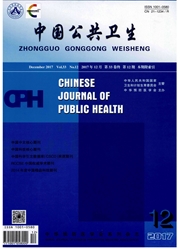

 中文摘要:
中文摘要:
目的研究转基因雄性小鼠不育的主要原因。方法以野生型C57BL/6J作为对照,比较检测健康性成熟雄性转基因小鼠的睾丸、附睾、前列腺、提肛肌的脏器系数和精子数、精子活动度、活精率、精子畸形率;观察睾丸组织病理学变化及睾丸组织葡萄-6-磷酸脱氢酶(G-6-PD)、乳酸脱氢酶(LDH)、乳酸脱氢酶同工酶(LDH-X)及琥珀酸脱氢酶(SDH)的活性。结果与正常非转基因对照鼠相比,转基因鼠睾丸的脏器系数与正常对照鼠相接近,附睾、提肛肌的脏器系数显著降低。精子数、直线运动精子数显著降低(P〈0.01);转基因鼠睾丸组织曲细精管变薄,生精细胞排列不整齐,层次减少(2层),上皮部分有变性,精原细胞、初级精母细胞分裂异常,精子形成减少;G-6-PD、LDH、LDH-X及SDH的活性均显著低于对照鼠。结论外源基因整合后,引起睾丸组织酶活性下降,影响各细胞的生理、生化功能,进而引起睾丸发育严重障碍,精子减少和活动能力降低而导致不育。
 英文摘要:
英文摘要:
Objective To investigate the main causes resluting in the transgenic mouse male infertility. Methods The coefficient of transgenic mouse testis, epididymidis, prostates, levator ani muscles and sperm population, sperm motility, living sperm rate the sperm deformity rate were examined in a comparative way with wild type C57BL/6J as well as the pathological changes of testis and the activities of glucose- 6 - phosphate dehydrogenase(G- 6 - PD), lactate dehydrogenase(LDH), lactate dehydrogenase isoenzyme X (LDH-X) and SDH in the testis. Results Compared with normal non - transgenic mouse C57BL/6J, a significant reduction in the relative weight of prostate and their epididymidis, levator ani muscles, and sperm population, linear- moving sperm rate(P 〈 0.01 ) were investigated. Testis structures of these transgenic mice changed apparently, the convoluted suminiferous tubules atteuatied, spermatogenic cell arrangement disordered, cell's layers number reduced(2 layers), part to epidermis denaturalized, spermatogenouse cells and primary spermatocytes abnormally divided, sperm formation reduced. The activities of G - 6 - PD, LDH, LDH - X and SDH were reduced significantly in transgenic mice. Conclusion Because of the testis tissue enzyme activities reduction after the exogenous gene integrated into the mouse genome, testis development and severely handicapped, sperm counts and sperm motility were decreased.
 同期刊论文项目
同期刊论文项目
 同项目期刊论文
同项目期刊论文
 期刊信息
期刊信息
